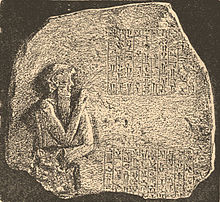Amraphel
In the Hebrew Bible, Amraphel /ˈæmrəˌfɛl/ (Hebrew: אַמְרָפֶל, romanized: ’Amrāp̄el; Greek: Ἀμαρφάλ, romanized: Amarphál; Latin: Amraphel) was a king of Shinar (Hebrew for Sumer) in Book of Genesis Chapter 14,[1] who invaded Canaan along with other kings under the leadership of Chedorlaomer, king of Elam. Chedorlaomer's coalition defeated Sodom and the other cities in the Battle of the Vale of Siddim.
Modern identifications[edit]

Beginning with E. Schrader in 1888,[2] Amraphel was usually associated with Ḫammurabi, who ruled Babylonia from 1792 BC until his death in 1750 BC. This view has been largely abandoned in recent decades.[3][4]
Recently, David Rohl argued for an identification with Amar-Sin, the third ruler of the Ur III dynasty.[5] Some suggest that Amraphel is a Semitic name that is composed of two elements, "Amar", which was also used by Sumerian King, Amar-Sin, and "a-p-l".[6] John Van Seters, in Abraham in History and Tradition, rejected the historical existence of Amraphel.[7]
In Rabbinic tradition[edit]
Rabbinic sources such as Midrash Tanhuma Lekh Lekhah 6, Targum Yonatan to Exodus 14:1, and Eruvin 53a[8]: 2 identify Amraphel with Nimrod. This is also asserted in the 11th chapter of the Sefer haYashar, attested from the early 17th century:
And Nimrod dwelt in Babel, and he there renewed his reign over the rest of his subjects, and he reigned securely, and the subjects and princes of Nimrod called his name Amraphel, saying that at the tower his princes and men fell through his means.
— Sefer haYashar 11
Genesis Rabbah 42 says Amraphel was called by three names: Cush, after his father's name (Gen. 10:8), Nimrod, because he established rebellion (mrd) in the world, and Amraphel, as he declared (amar) "I will cast down" (apilah).
References[edit]
- ^ Genesis chapter 14, verses 1 and 9
- ^ Cuneiform Inscriptions and the Old Testament, vol II (1888), pp 299ff
- ^ Robert North (1993). "Abraham". In Bruce M. Metzger; Michael D. Coogan (eds.). The Oxford Companion to the Bible. Oxford: Oxford University Press. p. 5. ISBN 0-19-504645-5.
- ^ Gard Granerød (26 March 2010). Abraham and Melchizedek: Scribal Activity of Second Temple Times in Genesis 14 and Psalm 110. Walter de Gruyter. p. 120. ISBN 978-3-11-022346-0.
- ^ Rohl (2010), p. 294.
- ^ Walton, John H., and Craig S. Keener. NRSV Cultural Backgrounds Study Bible: Bringing to Life the Ancient World of Scripture. Zondervan, 2019. p. 39.
- ^ Seters, John Van (March 2014). Abraham in History and Tradition. Echo Point Books and Media. ISBN 978-1-62654-910-4.
- ^ "The Soncino Babylonian Talmud" (PDF). Halakhah.com. Retrieved 13 January 2017.
Bibliography[edit]
- Irving L. Finkel, The Ark Before Noah: Decoding the Story of the Flood (Knopf Doubleday Publishing Group, 2014).
- Rohl, David (2010). The Lords of Avaris. Random House.
